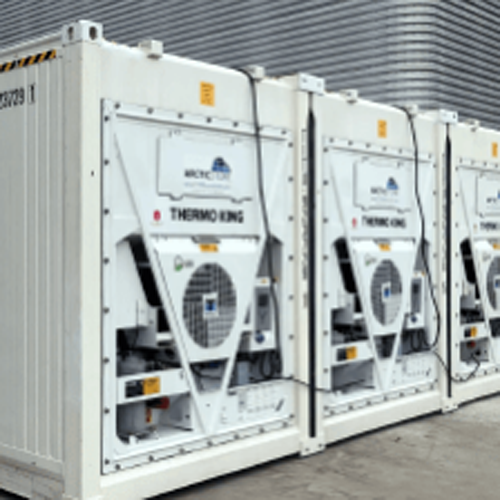Modern medical advancements are revolutionising the healthcare space, with companies investing significant time and resources into developing life-changing therapeutics.
However, for these therapeutics to positively impact the patients that receive them, they often need to be distributed in specific conditions.
A critical factor that’s often overlooked when transporting pharmaceuticals is temperature control — as conditions fluctuate during storage and shipping, so does their efficacy and safety.
The losses associated with pharmaceutical waste are not only financial; they can delay the delivery of essential therapeutics and result in environmental damage from drug disposal.1
Identifying weaknesses in cold storage chain, using temperature control systems and electronic monitoring systems, maintaining risk mitigation strategies, ensuring visibility within the partner network and ensuring compliance with global regulations are all ways in which companies can minimise losses, reports Mark Ross, Global Brand Manager for TITAN Containers ArcticStore.
How do temperature changes impact the industry?
Many medications — particularly antibiotics and vaccines — are sensitive to temperature fluctuations, as well as exposure to adverse humidity levels.
When exposed to temperatures beyond their recommended range, these medications can lose their potency.2 As well as this, significant temperature changes can also have the following effects.
- Compromise efficacy: A reduction in the functionality of a medication can pose significant health risks to those taking it. Issues in the supply chain regarding temperature regulation became particularly evident during the COVID-19 pandemic, with accessibility being reduced in developing countries who didn’t have the facilities to store vaccines.3 Other therapeutics such as monoclonal antibodies need to be stored at temperatures between −20 and −80 °C.4 When kept in warm conditions outside of the manufacturer’s recommendations, efficacy will dramatically decrease.5
- Waste money and resources: It’s estimated that approximately half of the vaccines distributed globally go to waste because of poor temperature management.6 A report by the United Nations Environment Programme claims that, at this spoilage rate, one billion vaccines could be wasted.7 Even if therapeutics are valued at a non-profit cost of $10 a dose, this constitutes a significant loss for manufacturers.
- Pollute the environment: With insufficient temperature control comes a surge in pharmaceutical waste, contributing to environmental pollution whilst necessitating complex disposal procedures. By implementing a comprehensive waste strategy, it’s estimated that this could save more than £11 million in costs and dramatically reduce carbon dioxide emissions.
- Damage the economy: Beyond financial losses, there are also broader economic impacts of drug loss. This includes an increase in healthcare costs owing to ineffective treatments and the need for additional medical interventions. The NHS spent nearly £19 billion in 2022/23 — an 8% increase from the previous year.8
- Harm business reputations: Failures in the cold storage supply chain may lead drug manufacturers to disclaim responsibility for product waste, meaning that logistics businesses will likely be held accountable for the loss. This can result in the tarnishing of their reputation.
Identifying weaknesses in the cold storage chain
To mitigate the risks associated with temperature fluctuations in the cold storage chain, it’s essential to evaluate the accuracy and reliability of monitoring devices and data logging systems.
These technologies must be capable of providing real-time data and generating automatic alerts when deviations occur — although ensuring their accuracy involves regular calibration and maintenance.
Failures in cold storage may easily be recognised when conditions such as condensation or mould growth. These are likely to happen when there is poor ventilation, fluctuations in temperature or materials are stored badly. Effective tracking systems are crucial to ensure that these problems are dealt with before risking product loss.
Ensuring remote access to tracking systems and real-time notifications is key in cold-storage management to address issues promptly, as well as minimising human error through regular staff training regarding the handling and transportation of temperature-sensitive pharmaceuticals.
Redundant temperature control systems are also beneficial to ensure that adequate power and cooling capabilities are available in the event of a failure.9 Backup generators or alternative cooling units will maintain temperatures and ensure that nothing goes to waste.
Prioritising compliance with regulatory standards

Regulatory bodies impose strict guidelines on temperature control during the storage and transportation of pharmaceuticals.10 Adhering to these standards not only upholds quality assurance, but also mitigates the risk of non-compliance penalties and any damage to reputation.
Regulatory standards vary significantly depending on which country you are trying to distribute to, so multinational pharmaceutical companies must navigate a range of different compliance landscapes. In this scenario, it’s logical for businesses to adopt the most stringent standards to ensure universal compliance and quality.
UK best practice
In the UK, best practice suggests that temperature monitoring should take place in all refrigerated transport — especially when shipping high-risk products — to ensure that data is gathered for the entire journey.
Daily assessments to record minimum and maximum temperatures should take place at all storage locations, with any recording devices being regularly calibrated for reading accuracy.
Using electronic tracking systems built into cold storage units allows for easy monitoring and enables records to be kept in one place. Regulations state that the data should be retained for a minimum of 5 years.
GDP inspections by the MHRA
The Medicines and Healthcare products Regulatory Agency (MHRA) in the UK does inspections to check that distribution sites comply with good distribution practice (GDP).11
During these visits, GDP inspectors will assess several aspects of a facility, including the equipment used to distribute medicines. This can also include temperature monitoring and transportation arrangements.

If an investigator finds critical deficiencies or a lack of improvement from previous inspections, companies may be subject to increased assessments or even a suspended license, which severely impacts distribution plans.
Although these regulations may seem onerous to comply with, maintaining comprehensive documentation of temperature control measures can pre-empt regulatory scrutiny and identify areas for improvement before external inspections.
Maintain risk mitigation strategies
There are several risks to consider in the logistics industry; these range from cybersecurity threats to transportation and equipment breakdowns. As supply chains become more complex, pharmaceutical and logistics industries are more at risk of being exploited by criminals.
In 2021, hackers targeted twelve COVID-19 vaccine developers. As well as this, a UK-based logistics company went into administration following a ransomware attack.13
These incidents highlight the real-world threats that can occur because of cyberattacks. Protecting against such threats requires robust cybersecurity measures, including data encryption and regular security audits.
Transportation delays
Transportation delays, which have recently been experienced in the Red Sea, have posed some significant challenges for global trade.14 As a result of unrest in the area, shipping companies have been forced to divert from usual trade routes and opt for more time-consuming journeys.
This poses challenges for logistics companies who need to keep their cargo at a specified temperature for longer periods.
Contingency plans and mitigation strategies are essential to address weaknesses in the distribution line … and can help to minimise the disruptions that may occur when transporting products internationally.
These plans should address issues such as equipment failure, transportation delays and temperature deviations.
Regular drills and scenario planning can help to ensure that teams are prepared to respond effectively to real-life incidents, minimising the impact on temperature-sensitive products.
Established crisis management teams, trained to handle specific types of disruptions, can ensure that problems are met with a swift response.
Ensure visibility within the partner network
Integrated tracking systems are a great way to improve transparency throughout the supply chain, empowering stakeholders to identify and address potential temperature deviations promptly.
With many shareholders involved in the logistics industry, each handoff in the supply chain introduces a potential risk for temperature deviations, mishandling or delays.
Reliable tracking systems can mitigate these risks by providing real-time data and alerts. In the event of a temperature deviation, stakeholders can take immediate action to prevent damage to the product.
As technology develops, maintaining digital records of temperature data becomes more efficient, ensuring transparency and accountability. Advanced sensors can continuously monitor environmental conditions and log this data to one platform that is easily accessible to multiple stakeholders.
By automating this process, companies can ensure that this data is up to date and accurate whilst reducing the risk of human error that could result from manual input.
This level of record keeping also facilitates compliance with regulatory requirements, as detailed accounts can be readily accessed and provided to authorities when needed.
It can also enhance trust and collaboration between shareholders and businesses, allowing everybody in the supply chain to be aware of the status of any shipment. This approach can both improve operational efficiency and strengthen relationships between partners.
References
- www.supplychainbrain.com/blogs/1-think-tank/post/35071-the-35-billion-challenge-using-supply-chain-intelligence-to-improve-pharma-operations.
- www.the-pda.org/temperature-management-of-medicines-in-a-pharmacy/.
- www.bbc.co.uk/news/technology-54889084.
- www.ncbi.nlm.nih.gov/pmc/articles/PMC2828577.
- www.ncbi.nlm.nih.gov/pmc/articles/PMC7905620/.
- www.ncbi.nlm.nih.gov/pmc/articles/PMC8473088/.
- www.unep.org/news-and-stories/story/why-optimized-cold-chains-could-save-billion-covid-vaccines.
- https://pharmaceutical-journal.com/article/news/nhs-drug-costs-in-england-rose-to-more-than-19bnin-2022-2023#:~:text=RPS%20elections%202024-,NHS%20drug%20costs%20in%20England%20rose%20to%20more%20than%20%C2%A3,bn%20spent%20in%202021%2F2022.
- https://control.com/technical-articles/what-is-redundancy-in-control-systems/.
- https://mhrainspectorate.blog.gov.uk/2016/05/05/refrigerated-medicinal-products-part-2-transportation-packing-temperature-management-the-use-of-third-party-couriers-and-returns-some-things-to-consider/.
- www.gov.uk/guidance/good-manufacturing-practice-and-good-distribution-practice.
- www.cbsnews.com/news/covid-19-vaccine-hackers-supply-chain/#:~:text=Hackers%20have%20targeted%20companies%20that,%22cold%20chain%22%20distribution%20system.
- www.infosecurity-magazine.com/news/uk-logistics-close-after/.
- www.imf.org/en/Blogs/Articles/2024/03/07/Red-Sea-Attacks-Disrupt-Global-Trade.
